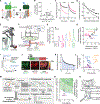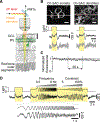Sustained deep-tissue voltage recording using a fast indicator evolved for two-photon microscopy
- PMID: 35985322
- PMCID: PMC9563101
- DOI: 10.1016/j.cell.2022.07.013
Sustained deep-tissue voltage recording using a fast indicator evolved for two-photon microscopy
Abstract
Genetically encoded voltage indicators are emerging tools for monitoring voltage dynamics with cell-type specificity. However, current indicators enable a narrow range of applications due to poor performance under two-photon microscopy, a method of choice for deep-tissue recording. To improve indicators, we developed a multiparameter high-throughput platform to optimize voltage indicators for two-photon microscopy. Using this system, we identified JEDI-2P, an indicator that is faster, brighter, and more sensitive and photostable than its predecessors. We demonstrate that JEDI-2P can report light-evoked responses in axonal termini of Drosophila interneurons and the dendrites and somata of amacrine cells of isolated mouse retina. JEDI-2P can also optically record the voltage dynamics of individual cortical neurons in awake behaving mice for more than 30 min using both resonant-scanning and ULoVE random-access microscopy. Finally, ULoVE recording of JEDI-2P can robustly detect spikes at depths exceeding 400 μm and report voltage correlations in pairs of neurons.
Keywords: GEVI; JEDI-2P; fly vision; genetically encoded voltage indicator; high-throughput screening; pairwise voltage correlations; random-access microscopy; starburst amacrine cells; two-photon fluorescence microscopy; voltage imaging.
Copyright © 2022 The Author(s). Published by Elsevier Inc. All rights reserved.
Conflict of interest statement
Declaration of interests F.S.-P. holds a US patent for a voltage sensor design (patent #US9606100 B2). F.S.-P., Z.L., and J.L. have filed a US patent for the SPOTlight screening method. S.D. and P.B. have ownership shares in Karthala Systems, a commercial supplier of RAMP microscopes.
Figures







References
-
- Abdelfattah AS, Farhi SL, Zhao Y, Brinks D, Zou P, Ruangkittisakul A, Platisa J, Pieribone VA, Ballanyi K, Cohen AE, and Campbell RE (2016). A bright and fast red fluorescent protein voltage indicator that reports neuronal activity in organotypic brain slices. J. Neurosci. 36, 2458–2472. 10.1523/JNEUROSCI.3484-15.2016. - DOI - PMC - PubMed
-
- Adhikari DP, Biener G, Stoneman MR, Badu DN, Paprocki JD, Eis A, Park PS-H, Popa I, and Raicu V (2021). Comparative photophysical properties of some widely used fluorescent proteins under two-photon excitation conditions. Spectrochim. Acta A Mol. Biomol. Spectrosc. 262, 120133. 10.1016/j.saa.2021.120133. - DOI - PubMed
Publication types
MeSH terms
Grants and funding
LinkOut - more resources
Full Text Sources
Other Literature Sources
Molecular Biology Databases
Research Materials

